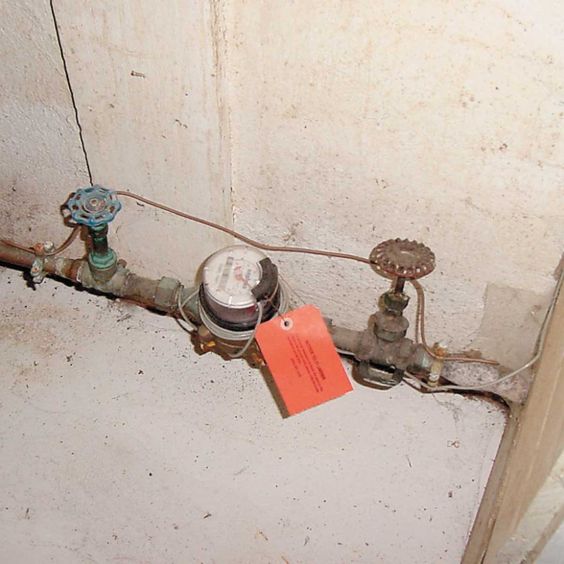Having the knowledge and ability to turn off the water main shut-off valve at the street is a fundamental skill that every homeowner should possess. It is a simple yet crucial task that can help you avoid potential disasters and costly damages. Imagine a burst pipe, a malfunctioning appliance, or a plumbing emergency — in these situations, the ability to quickly shut off the water supply can be a game-changer.
What is a Main Water Shut-Off Valve

The main water shut-off valve is critical to your home’s plumbing system. It is the primary control point for regulating the water flow into your house. By turning off the water at the street, you can effectively stop the water supply, giving you the power to prevent potential disasters and address plumbing emergencies.
Locating the main shut-off valve may vary depending on the construction and layout of your home. In many cases, you can find it inside the house, typically in the basement or in a closet in the front room. It may also be positioned on an exterior wall, especially in warmer regions, or even housed in a meter box near the street.
When it comes to valve types, there are a couple of variations you might encounter. One common type is the gate valve, which features a round handle that you rotate to turn the valve on or off. Gate valves usually require multiple rotations to fully open or close, necessitating a check to ensure the valve is completely open or shut.
Another type is the ball valve, which is more prevalent in newer homes. Ball valves have a lever handle you need to pull in a specific direction to control the water flow. Unlike gate valves, ball valves offer a more straightforward operation, eliminating the need for multiple rotations.
Locating the Main Water Shut-Off Valve

Knowing the specific location of the main shut-off valve in your home is crucial to quickly and effectively control the water flow during emergencies or when conducting plumbing repairs. Here are step-by-step instructions for finding the valve based on different scenarios:
- In the Basement:
- Head to the basement of your home.
- Look along the walls, particularly near the front or back of the house.
- The main shut-off valve is commonly located near the water meter or where the main water line enters the house.
- It may be positioned on a pipe coming out of the floor or on a wall.
- On an Exterior Wall:
- Go outside your house and identify the exterior walls, particularly the front wall.
- Look for any exposed pipes or utility boxes attached to the wall.
- The main shut-off valve is often found near an outside faucet or hose bib.
- It may be housed in a protective box or behind a removable panel.
- In a Meter Box Near the Street:
- Locate the water meter on your property, typically near the street or curb.
- Check for a meter box nearby, which is usually a rectangular or circular cover.
- Use a meter box key or a suitable tool to open the cover, access the meter, and shut off the valve.
- The main shut-off valve will be inside the meter box, close to the meter itself.
Remember, the specific location of the main shut-off valve may vary depending on the construction of your home and regional practices. It’s important to familiarize yourself with the unique layout of your house and locate the valve before an emergency occurs. This knowledge will help you save valuable time during critical situations, enabling you to act swiftly and minimize the potential damage caused by uncontrolled water flow.
Turning Off the Water Supply at the Street
In certain circumstances, it may be necessary to turn off the water supply at the street level. This can occur when the main water shut-off valve leaks, there is a leak or burst pipe between the street and the inside valve, or when replacing the main water valve. Knowing how to perform this task is essential for homeowners looking to take control of their water supply. Here’s a guide on how to turn off the water at the street:
- Assess the Situation:
- Determine if turning off the water at the street is necessary. This may include situations where the inside main water valve is stuck or not functioning correctly, or when there is a significant leak or burst pipe between the street and the inside valve.
- Gather the Required Tools:
- Depending on the type of street water shut-off valve, you may need specific tools. Common tools include a water meter key, a wrench, or channel locks.
- Ensure you have the appropriate tools on hand before attempting to shut off the water at the street.
- Locate the Water Meter and Shut-Off Valve:
- Find the water meter on your property, typically positioned near the street or curb.
- The shut-off valve is usually located within the meter box, adjacent to the water meter. It may require the use of a water meter key or a wrench to access and operate the valve.
- Shutting Off the Water:
- Insert the water meter key into the meter box’s access point or use a wrench suitable for the valve type.
- Apply gentle pressure and turn the key or wrench clockwise to close the shut-off valve.
- Keep in mind that some street water shut-off valves may require a bit of force to turn, but it’s crucial to exercise caution and avoid excessive pressure to prevent damage or potential flooding.
- Confirm that the valve is fully closed by checking for a complete cessation of water flow inside your home.
Situations Requiring To Close the Street Valve

When it comes to plumbing emergencies or unexpected water-related mishaps in your home, time is of the essence. Knowing when and how to turn off the main water supply can make a significant difference in mitigating damage and protecting your property. Here are some scenarios that require immediate action:
Plumbing Emergencies
A sudden and severe plumbing issue, such as a burst pipe, requires immediate attention. The forceful flow of water can cause extensive damage to your walls, floors, and belongings. Turning off the main water supply is crucial to stop the water flow and minimize the impact.
Burst Pipes
Burst pipes can occur due to freezing temperatures, excessive pressure, or aging plumbing systems. The gushing water from a burst pipe can lead to flooding and structural damage. Act quickly by shutting off the main water supply to prevent further water damage and reduce the risk of mold growth.
Preventing Major Damage with Quick Response
While knowing how to turn off the main water supply is essential, being proactive and prepared can help prevent major damage before it even occurs. Here are some practical tips to help you minimize the risks and protect your home:
Create a Family Plan
It’s crucial that every member of your household knows the location of the main water shut-off valve and how to operate it. In case of an emergency, such as a burst pipe or overflowing toilet, quick action can make a significant difference. Take the time to educate your family members about the main shut-off valve’s location and provide clear instructions on how to turn it off. Consider conducting a practice drill so everyone feels confident in their ability to respond during a crisis.
Emergency Contact Information
Alongside the main water shut-off valve, keep a list of emergency contact numbers, including a reliable plumber, near the shut-off valve. In case you need immediate professional assistance, having the contact information readily available will save you valuable time during a stressful situation. Store this information in your cell phones, or keep a business card or magnet with emergency numbers on your refrigerator for quick access.
Routine Maintenance
Taking proactive measures through routine maintenance can help prevent major failures and repairs in your water lines. Regularly inspect your plumbing system for any signs of leaks, corrosion, or worn-out components. Consider scheduling periodic check-ups with a professional plumber to identify potential issues before they escalate. They can also provide guidance on maintaining your plumbing system and offer recommendations for upgrades or repairs.
Temperature Monitoring
In regions prone to freezing temperatures, it’s essential to monitor the temperature in areas where pipes are exposed, such as basements, attics, or crawl spaces. During colder months, keep the thermostat set to a temperature that prevents pipes from freezing. Additionally, insulate exposed pipes with foam sleeves or heat tape to provide an extra layer of protection.
Leak Detection Systems
Installing a leak detection system can provide an added layer of security. These systems monitor water flow and detect leaks or unusual activity in your plumbing system. They can alert you through mobile apps or audible alarms, allowing you to take prompt action and minimize potential damage.
By implementing these preventive measures, you can significantly reduce the chances of major plumbing emergencies and the subsequent damage they may cause. A combination of preparedness, routine maintenance, and proactive steps will give you peace of mind and help safeguard your home’s water supply.
Remember, if you do encounter a plumbing issue that requires professional assistance, don’t hesitate to contact a trusted plumber. Their expertise and experience will ensure that repairs are carried out effectively, helping you restore your water supply and maintain a safe and functional home.
Final Words
In situations where turning off the water at the street becomes necessary, such as valve failure, pipe leaks, or valve replacements, we have provided you with valuable insights. Armed with the right tools, such as a water meter key, wrench, or channel locks, you can confidently navigate the process of shutting off the water at the street. Remember, caution and gentle force are key to avoiding any unintended consequences or further damage.
Last Updated on June 28, 2023

Dustin Hopkins has over 12 years in the cleaning industry, working in the past for one of the top 5 cleaning companies in the US. Currently, he is the chief editor of CleaningRank.com and the proud father of a 5-year-old, Chris.
